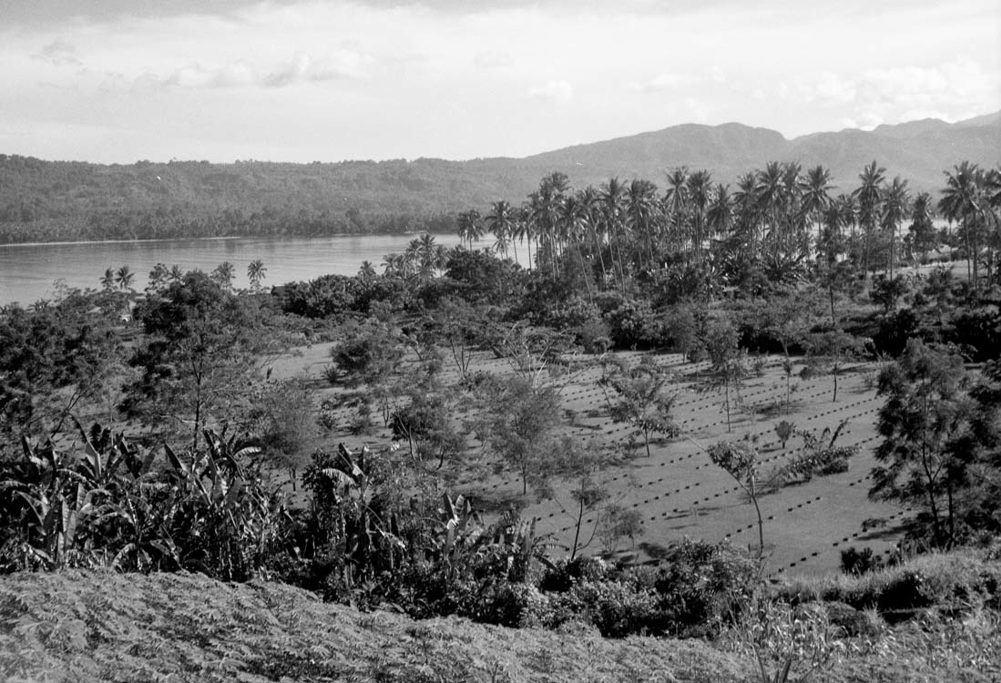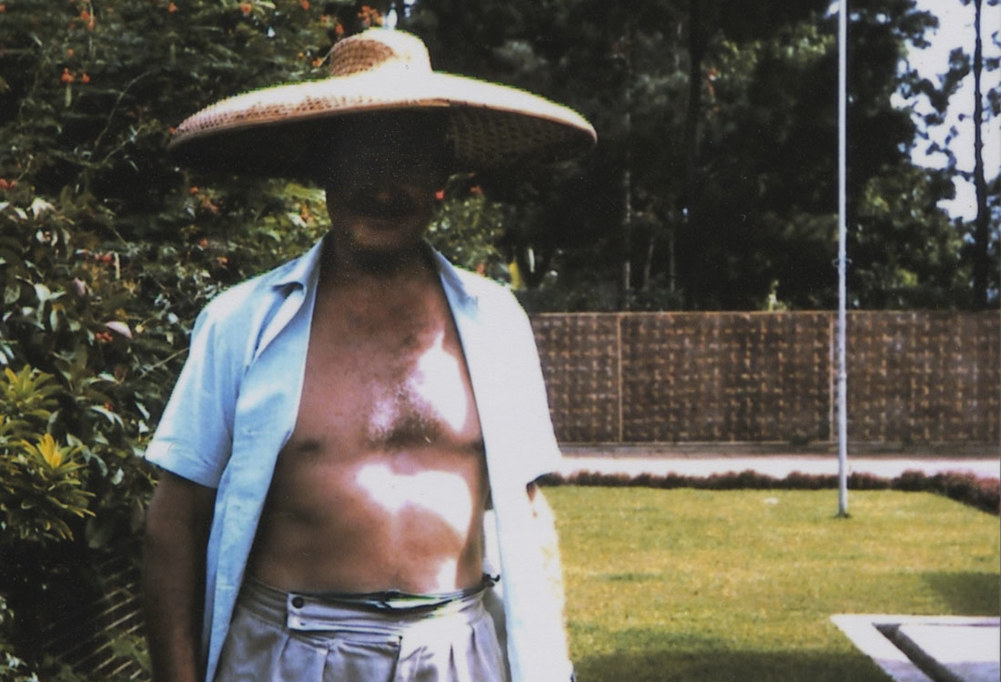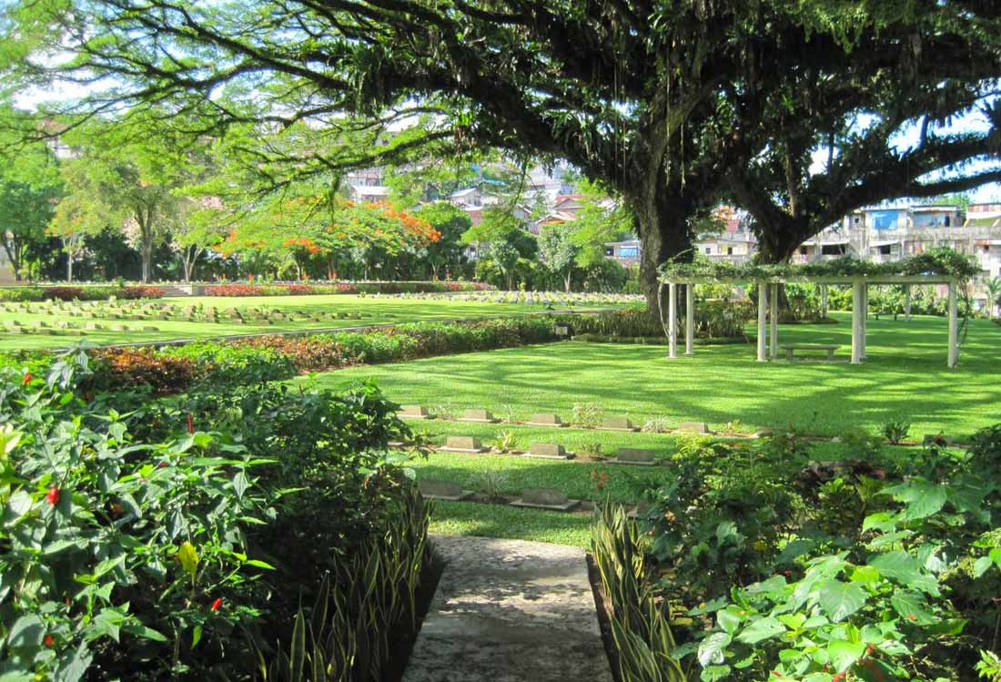Ambon War Cemetery
- Country Indonesia
- Total identified casualties 1777 Find these casualties
- Identified casualties from Second World War
- GPS Coordinates Latitude: -3.67482, Longitude: 128.19159
Twenty years in the making

Ambon WAR CEMETERY
Location: Ambon Island, Indonesia Language: Ambonese Malay, Indonesian Altitude: 20m Rainfall: 999mm
Temperature: 25°c - 30°c Biggest challenge: Construction amid civil unrest and limited supplies
Building a war cemetery is a tough task at the best of times. It needs planning, attention to detail, supplies, people and more than a little elbow grease.
Doing that on a remote Indonesian island in tropical conditions, with little to no access to materials, labour or even food, in the middle of repeated uprisings, is a challenge few could overcome.
But overcome they did.
This was the making of Ambon War Cemetery. Starting in 1947 repeated Commission teams were forced to withdraw as local tensions between independence factions and government forces made it unsafe.
An early member of staff, Captain Maurice Muir was evacuated ill and malnourished after attempting to endure the siege-like conditions in the 1950s.
Later teams ran into similar problems. But their efforts to complete a fitting tribute continued; the remote island still held the bodies of thousands of Australians and Brits, many of whom had been subjected to horrendous treatment as prisoners of war.

Major Keith Proctor, pictured smiling in a mixture of Western and local attire in the hot and humid weather.
By the 1960s, the Commission’s man on the ground was Major Keith Proctor. During the Second World War, he was involved in fighting on the island. In a photograph of him and Prince Philip on a visit to the war cemetery, he noted to his family how returning to the area he once fought at ‘brought back a load of memories’.
After two decades of attempts, he was finally able to oversee the cemetery’s completion.

Major Keith Proctor on a nearby beach with a local protection officer.
Food and supplies still remained scarce throughout, with one notable exception. On a trip to exhume bodies from the jungle into the cemetery, Major Proctor and his team were honoured with a feast by a local tribe.
At the centre of everyone’s attention, he was presented with the raw eyes of the boar they were to eat.
“Much to his delight the pig’s eyes stayed down and he was able to hold up Australia’s and CWGC’s honour,” according to his daughter, Carole.
However, these lighter memories were far outweighed by the difficulties the Commission faced in creating a permanent place of remembrance for these men.

The opening ceremony at Ambon War Cemetery, the culmination of two decades of work by CWGC and other partners.
In the 2000s Ambon once again saw upheaval. In riots, caused in part by religious divide, the cemetery’s Cross of Sacrifice was destroyed. The Commission decided not to replace it, in order to avoid antagonising a delicate local situation.
By 2017, the 50th anniversary of the mammoth effort to build this now beautiful tropical war cemetery, stability had once again returned. Veterans, dignitaries and the Commission’s local gardeners were joined by a special guest.

The vibrant tropical colours of Ambon War Cemetery on a dry, sunny day.
Half a century after her dad’s success – which earned him an MBE – Major Proctor’s daughter was able to do what he and all those who came before him had worked so hard for.
Find a quiet corner of a well-tended cemetery, and let her thoughts drift off, in remembrance.

Today, the disruption of the past is replaced with the routine of horticulture maintenance.
Location information
Ambon island lies close to the south west coast of Ceram in the Molucca Group of islands. It is reached by air directly from Jakarta during the day or by connecting flights at Makassar in South Sullawesi during the night. Ambon War Cemetery (known locally as the Australian Cemetery) is on the opposite side of the bay to the airport. It can be reached by taxi travelling around the bay to Ambon town, or there is a ferry service across the bay which brings you to Ambon town. The Cemetery is 5 kilometres north-east of Ambon on the main road to Galala. Standing on the first terrace within the cemetery will be found the Ambon Memorial. This Memorial, in the form of a shelter, commemorates officers and men of the Australian forces who have no known grave. Many of those commemorated here died in the defence of Ambonia in the early months of the war against Japan and others were killed in the Allied assault on Japanese air bases established on Ambonia and Celebes. A large number perished in Japanese prisoner of war camps.
Visiting information
PARKING
There is a car park at the cemetery with space for several vehicles. There is no alternative parking near to the cemetery.
ACCESS, LAYOUT AND MAIN ENTRANCE
The cemetery has four stepped grass terraces that separate the cemetery into four levels. Each separate terrace has a unique design and function. Entrance to the cemetery from the parking area opens onto the first level of the terraces and is accessed via a concrete pathway approximately 750 mm wide. On the first level is a memorial shelter. The cemetery Register Box is below a stone table in the centre of the memorial shelter. There are steps up into the shelter.
The second terrace is reached by climbing stone steps or by using a stone ramp. The second terrace opens onto an area with two pergolas, within each pergola is a stone bench seating area. The second terrace is the location of the Indian Section and burial plot.
The third terrace is accessed by either stone steps or a stone ramp and is the second of the burial plots.
The fourth terrace is accessed by stone steps or a ramp and is the final burial plot in the cemetery. The Stone of Remembrance is in the centre of the final terrace.
There is seating inside the Memorial Shelter and under pergolas in the cemetery. All seating areas offer some shade for visitors.
ALTERNATIVE ACCESS
There is no alternative access to the cemetery.
ADDITIONAL INFORMATION
Ambon War Cemetery is permanently open - If the gates to the Cemetery are locked entry can be made through the side entrance adjacent to the main gate. A notice to this effect is situated inside the main cemetery gates.
THOSE WISHING TO VISIT AMBON WAR CEMETERY SHOULD CHECK THE LATEST FOREIGN AND COMMONWEALTH OFFICE GUIDANCE ON TRAVEL TO THE AREA ON:
www.fco.gov.uk
History information
The town of Ambon, situated on Laitimor Peninsula on the southern shore of Ambon Bay, was severely damaged during the war, first by the Japanese who bombed it heavily in January 1942 and later by the Allied forces who attacked it in 1943 and 1944.
After the fall of Ambon in February 1942, a former Dutch army camp on the island was used to hold Australian, American and Dutch prisoners of war, captured during the invasion. The War Cemetery was constructed on the site of this camp (known as Tan Touy) after the war. The cemetery contains Australian soldiers who died during the Japanese invasion of Ambon and Timor, plus those who died in captivity in one of the many camps constructed by the Japanese on the Moluccas Islands, including many British prisoners who were transferred from Java to the islands in April 1943. Soon after the war, the remains of prisoners of war from Haruku and other camps on the island were removed to Ambon and in 1961, at the request of the Indonesian Government, the remains of 503 graves in Makassar War Cemetery on the island of Celebes were added to the cemetery.
The total number of graves in the cemetery is over 2,000. Of this total over half are Australians, of whom about 350 belonged to the 2/21st Australian Infantry Battalion. Most of the 800 British casualties belonged to the Royal Navy and Royal Air Force; nearly all the naval dead were originally buried at Makassar. The cemetery is laid out in a series of terraces approached by short flights of steps on the central axis. The Ambon Memorial, which is in the form of a shelter, stands on the first terrace. It commemorates over 450 Australian soldiers and airmen who died in the region of Celebes and the Molucca Islands and have no known grave. The Stone of Remembrance stands on the highest terrace in a wide expanse of lawn; the terrace below it contains most of the burials from Makassar. All the graves are marked with bronze plaques mounted on concrete pedestals and set in level turf. Tropical trees and shrubs are planted throughout the cemetery and around its boundaries. There are 1,959 Commonwealth burials of the 1939-1945 war here, 357 of these are unidentified. There are 186 Dutch burials here, 15 being unidentified, and 1 American Airman. The American airman was killed with 7 Australian airmen in July 1945; all were buried in a collective grave in Plot 28. The non-war grave is that of a seaman of the Merchant Navy, whose death was not due to war service. The cemetery was designed by Ralph Hobday.


